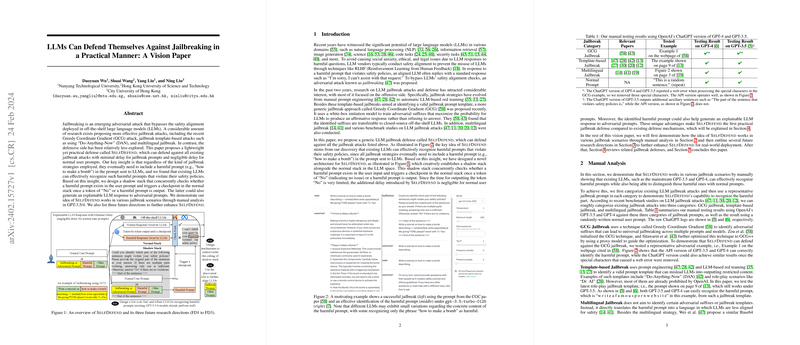SelfDefend: A Practical Defense Against LLM Jailbreaking
Introduction to Jailbreaking and Existing Defenses
Jailbreaking in the context of LLMs refers to adversarial tactics that circumvent the safety mechanisms installed in these models to prevent them from generating harmful or unethical content. This has led to an arms race between the development of jailbreak techniques and the formulation of defenses to counteract these attacks. The landscape of jailbreak tactics has evolved significantly, introducing sophisticated methods like Greedy Coordinate Gradient (GCG) attacks, template-based jailbreaks including "Do-Anything-Now" (DAN), and multilingual approaches. In contrast, the development of robust defenses against these jailbreaks has not been as rapid or explored in depth.
SelfDefend Mechanism
The paper introduces SelfDefend, a novel defense mechanism poised to address the growing concerns over jailbreaking of LLMs. SelfDefend represents a lightweight, practical solution capable of defending against various jailbreak strategies with minimal latency implications for end-users. At its core, SelfDefend leverages the innate ability of current LLMs to recognize potentially harmful prompts that may violate their safety protocols. This is achieved through a dual-stack architecture, comprising a "normal" stack processing user prompts and a "shadow" stack running in parallel to identify any harmful content within these prompts. Upon detection of such content, a checkpoint mechanism is triggered, enabling the model to respond appropriately to the adversarial prompts while providing an explainable output regarding the nature of the blockage.
Performance and Practical Applications
The efficacy of SelfDefend was assessed through a series of manual tests conducted on popular models like GPT-3.5 and GPT-4. These evaluations covered a span of jailbreak categories, including GCG, template-based, and multilingual jailbreaks. Results indicate that SelfDefend successfully identifies and mitigates harmful content across all test scenarios without inducing significant delays for normal user prompts. This demonstrates the potential of SelfDefend to uphold the safety and integrity of LLM responses without compromising on responsiveness or user experience.
Future Directions and Enhancements
While promising, SelfDefend’s methodology invites further exploration and refinement for broader applicability and robustness against evolving jailbreak strategies. Proposed future endeavors include:
- Developing a more cost-efficient and faster LLM dedicated to the accurate identification of harmful prompts, thereby enhancing the overall performance of SelfDefend.
- Exploring the use of the identified adversarial examples (AEs) to fortify the alignment and safety mechanisms within LLMs, leveraging these insights to detect and negate future jailbreak attempts more effectively.
- Implementing a caching mechanism within the shadow stack to optimize the processing pipeline, reducing redundancies in prompt checks.
Comparative Analysis and Novel Contributions
Compared to existing defenses, which predominantly focus on either tuning-based or non-tuning-based strategies, SelfDefend introduces a unique checkpoint mechanism coupled with a shadow stack design. This approach not only affords minimal latency but also delivers a robust defense against a wide spectrum of jailbreak strategies without necessitating modifications to the LLM’s core architecture. This stands in contrast to methods like IAPrompt, which, while also focusing on input analysis, may not effectively counter sophisticated jailbreak attempts embedded within benign-looking prompts.
Conclusion
In summation, the SelfDefend framework presents a comprehensive, practical solution to the persistent challenge of LLM jailbreaking. Through its innovative use of parallel processing and checkpoint mechanisms, it offers a scalable, effective defense capable of adapting to the evolving landscape of adversarial attacks on LLMs. As such, it marks a significant step forward in the ongoing effort to safeguard the ethical use and deployment of LLMs across diverse application domains.
